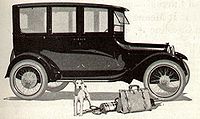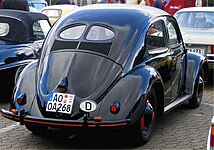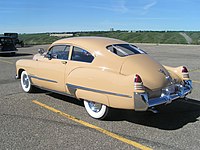Sedan (automobile)
The examples and perspective in this article deal primarily with the United States and do not represent a worldwide view of the subject. (February 2021) |
A sedan or saloon (British English)[1][2] is a passenger car in a three-box configuration with separate compartments for an engine, passengers, and cargo.[3] The first recorded use of sedan in reference to an automobile body occurred in 1912.[4] The name derives from the 17th-century litter known as a sedan chair, a one-person enclosed box with windows and carried by porters. Variations of the sedan style include the close-coupled sedan, club sedan, convertible sedan, fastback sedan, hardtop sedan, notchback sedan, and sedanet.
Definition
[edit]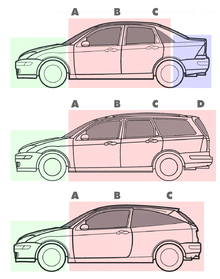
A sedan (/sɪˈdæn/) is a car with a closed body (i.e., a fixed metal roof) with the engine, passengers, and cargo in separate compartments.[5] This broad definition does not differentiate sedans from various other car body styles. Still, in practice, the typical characteristics of sedans are:
- a B-pillar (between the front and rear windows) that supports the roof;[6]
- two rows of seats;[7]: 134
- a three-box design with the engine at the front and the cargo area at the rear;[8][9]
- a less steeply sloping roofline than a coupé results in increased headroom for rear passengers and a less sporting appearance;[10] and
- a rear interior volume of at least 33 cu ft (0.93 m3).[11][12]
It is sometimes suggested that sedans must have four doors (to provide a simple distinction between sedans and two-door coupés); others state that a sedan can have four or two doors.[7]: 134 [13][14] Although the sloping rear roofline defined the coupe, the design element has become common on many body styles with manufacturers increasingly "cross-pollinating" the style so that terms such as sedan and coupé have been loosely interpreted as "'four-door coupes' - an inherent contradiction in terms."[15][16]
When a manufacturer produces two-door sedan and four-door sedan versions of the same model, the shape and position of the greenhouse on both versions may be identical, with only the B-pillar positioned further back to accommodate the longer doors on the two-door versions.[17]
Etymology
[edit]
A sedan chair, a sophisticated litter, is an enclosed box with windows used to transport one seated person. Porters at the front and rear carry the chair with horizontal poles.[18] Litters date back to long before ancient Egypt, India, and China. Sedan chairs were developed in the 1630s. Etymologists suggest the name of the chair very probably came through varieties of Italian from the Latin sedere, or the Proto-Indo-European root "sed-" meaning "to sit."[19][20]

The first recorded use of sedan for an automobile body occurred in 1912 when the Studebaker Four and Studebaker Six models were marketed as sedans.[19][21] There were fully enclosed automobile bodies before 1912. Long before that time, the same fully enclosed but horse-drawn carriages were known as a brougham in the United Kingdom, berline in France, and berlina in Italy; the latter two have become the terms for sedans in these countries. It is sometimes stated that the 1899 Renault Voiturette Type B (a 2-seat car with an extra external seat for a footman/mechanic) was the first sedan, since it is the first known car to be produced with a roof. A one-off instance of similar coachwork is also known in a 1900 De Dion-Bouton Type D.[22][23]
A sedan is typically considered to be a fixed-roof car with at least four seats.[19] Based on this definition, the earliest sedan was the 1911 Speedwell, which was manufactured in the United States.[24]: 87
International terminology
[edit]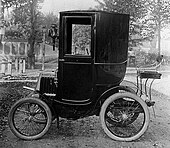
In American English, Latin American Spanish, and Brazilian Portuguese, the term sedan is used (accented as sedán in Spanish).[25] In British English, a car of this configuration is called a saloon (/səˈlun/).[2] Hatchback sedans are known simply as hatchbacks (not hatchback saloons); long-wheelbase luxury saloons with a division between the driver and passengers are limousines.[citation needed]
In Australia and New Zealand, sedan is now predominantly used; they were previously simply cars. In the 21st century, saloon remains in the long-established names of particular motor races.[citation needed] In other languages, sedans are known as berline (French), berlina (European Spanish, European Portuguese, Romanian, and Italian), though they may include hatchbacks. These names, like the sedan, all come from forms of passenger transport used before the advent of automobiles. In German, a sedan is called Limousine and a limousine is a Stretch-Limousine.[26]
In the United States, two-door sedan models were marketed as Tudor in the Ford Model A (1927–1931) series.[27] Automakers use different terms to differentiate their products and for Ford's sedan body styles "the tudor (2-door) and fordor (4-door) were marketing terms designed to stick in the minds of the public."[27] Ford continued to use the Tudor name for 5-window coupes, 2-door convertibles, and roadsters since all had two doors.[28] The Tudor name was also used to describe the Škoda 1101/1102 introduced in 1946.[29] The public popularized the name for a two-door model and was then applied by the automaker to the entire line that included a four-door sedan and station wagon versions.[29]
Standard styles
[edit]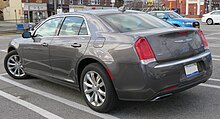
Notchback sedans
[edit]In the United States, the notchback sedan distinguishes models with a horizontal trunk lid. The term is generally only referred to in marketing when it is necessary to differentiate between two sedan body styles (e.g., notchback and fastback) of the same model range.
Liftback sedans
[edit]Several sedans have a fastback profile but a hatchback-style tailgate is hinged at the roof. Examples include the Peugeot 309, Škoda Octavia, Hyundai Elantra XD, Chevrolet Malibu Maxx, BMW 4 Series Grand Coupe, Audi A5 Sportback, and Tesla Model S. The names hatchback and sedan are often used to differentiate between body styles of the same model. To avoid confusion, the term hatchback sedan is not often used.
Fastback sedans
[edit]There have been many sedans with a fastback style.
-
1950 Volkswagen Beetle
-
1939 Lincoln-Zephyr
-
1948 Cadillac Series 62
-
2013 Mercedes-Benz CLS
Hardtop sedans
[edit]

Hardtop sedans were a popular body style in the United States from the 1950s to the 1970s. Hardtops are manufactured without a B-pillar leaving uninterrupted open space or, when closed, glass along the side of the vehicle.[31][32][33] The top was intended to look like a convertible's top. However, it was fixed and made of hard material that did not fold.[26]
All manufacturers in the United States from the early 1950s into the 1970s provided at least a two-door hardtop model in their range and a four-door hardtop. The lack of side bracing demanded a strong, heavy chassis frame to combat unavoidable flexing. The pillarless design was also available in four-door models using unibody construction.[34] For example, Chrysler moved to unibody designs for most of its models in 1960 and American Motors Corporation (AMC) offered four-door sedans, as well a four-door station wagon from 1958 until 1960 in the Rambler and Ambassador series.[35]
In 1973, the US government passed Federal Motor Vehicle Safety Standard 216 creating a standard roof strength test to measure the integrity of roof structure in motor vehicles to come into effect some years later. The objective was to reduce deaths and injuries due to the car's roof crushing into the passenger compartment in case of a rollover crash.[36] Hardtop sedan body style production ended with the 1978 Chrysler Newport. Roofs were often available with standard or optional vinyl cover.[37] The structural B-pillar design was minimized by styling methods like matt black finishes. Stylists and engineers soon developed more subtle solutions.[26]
Mid-20th century variations
[edit]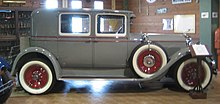
Close-coupled sedans
[edit]A close-coupled sedan is a body style produced in the United States during the 1920s and 1930s. Their two-box boxy styling made these sedans more like crossover vehicles than traditional three-box sedans. Like other close-coupled body styles, the rear seats are farther forward than a regular sedan.[7]: 43 [38] This reduced the length of the body; close-coupled sedans, also known as town sedans, were the shortest of the sedan models offered.[39]
Models of close-coupled sedans include the Chrysler Imperial,[40][41] Duesenberg Model A,[42] and Packard 745[43]
Coach sedans
[edit]
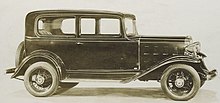
A two-door sedan for four or five passengers but with less room for passengers than a standard sedan. A Coach body has no external trunk for luggage. Haajanen says it can be difficult to tell the difference between a Club and a Brougham and a Coach body, as if manufacturers were more concerned with marketing their product than adhering to strict body style definitions.[26]

Close-coupled saloons
[edit]Close-coupled saloons originated as four-door thoroughbred sporting horse-drawn carriages with little room for rear passengers' feet. In automotive use, manufacturers in the United Kingdom used the term to develop the chummy body, where passengers were forced to be friendly because they were tightly packed. They provided weather protection for extra passengers in what would otherwise be a two-seater car. Two-door versions would be described in the United States and France as coach bodies.[44] A postwar example is the Rover 3 Litre Coupé.
Club sedans
[edit]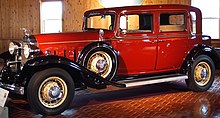
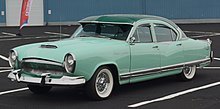
Produced in the United States from the mid-1920s to the mid-1950s, the name club sedan was used for highly appointed models using the sedan chassis.[7]: 44 Some people describe a club sedan as a two-door vehicle with a body style otherwise identical to the sedan models in the range.[45] Others describe a club sedan as having either two or four doors and a shorter roof and therefore less interior space than the other sedan models in the range.[7]: 44
Club sedan originates from a railroad train's club carriage (e.g.,, the lounge or parlour carriage).[7]: 44
Sedanets
[edit]
From the 1910s to the 1950s, several United States manufacturers have named models either Sedanet or Sedanette. The term originated as a smaller version of the sedan;[46] however, it has also been used for convertibles and fastback coupes. Models that have been called Sedanet or Sedanette include the 1917 Dort Sedanet,[47] King,[46] 1919 Lexington,[46] 1930s Cadillac Fleetwood Sedanette,[48] 1949 Cadillac Series 62 Sedanette,[49] 1942-1951 Buick Super Sedanet,[50][51] and 1956 Studebaker.
See also
[edit]References
[edit]- ^ "saloon (noun)". Oxford Learner's Dictionaries. Retrieved 1 December 2024.
- ^ a b "saloon". Cambridge Dictionary. Retrieved 1 December 2024.
- ^ "Car Design Glossary - Part 2: One-Box (Monospace or Monovolume)". Car Design News. Archived from the original on 3 December 2013. Retrieved 9 September 2015.
The principal volumes of the traditional sedan can be split into separate compartments or boxes: the hood/bonnet is the first box; the passenger compartment the second, and the trunk/boot the third - i.e. it's a 'three-box' car.
- ^ "Where Does the Word "Sedan" Come From?". thenewswheel.com. 10 January 2017. Retrieved 1 December 2024.
- ^ "Definition of sedan in English by Oxford Dictionaries". oxforddictionaries.com. Archived from the original on 26 September 2016. Retrieved 25 November 2018.
- ^ Duffy, James (2008). Auto Body Repair Technology (Fifth ed.). Cengage Learning. pp. 27–28. ISBN 9781418073541. Retrieved 9 September 2015.
- ^ a b c d e f Haajanen, Lennart W. (2007). Illustrated Dictionary of Automobile Body Styles. McFarland. ISBN 9780786437375. Retrieved 9 September 2015.
- ^ Morello, Lorenzo (2011). The automotive body - Volume I, Components design. Springer. p. 184. ISBN 9789400705128. Retrieved 9 September 2015.
- ^ "Starting Out: Car Design Glossary - Part 2". cardesignnews.com. Archived from the original on 3 December 2013.
- ^ "What is the difference between coupe and sedan?". chicagotribune.com. 26 August 2017. Retrieved 25 November 2018.
- ^ "Club Coupes". hemmings.com. Retrieved 7 December 2018.
- ^ "Coupe vs. Sedan: What's the Difference and Definitions of the Body Styles?". automoblog.net. 12 February 2009. Retrieved 7 December 2018.
- ^ Morello, L.; Rossini, Lorenzo Rosti; Pia, Giuseppe; Tonoli, Andrea (2011). The Automotive Body: Volume I: Components Design. Springer Science & Business Media. p. 184. ISBN 9789400705135.
- ^ "Coupe vs. Sedan: What's the Difference and Definitions of the Body Styles?". automoblog.net. 12 February 2009. Retrieved 25 November 2018.
- ^ Stewart, Jack. "Range Rover's $295K Coupe SUV Proves No Niche Is Too Small". Wired. Retrieved 25 November 2018.
- ^ Stafford, Eric (24 July 2019). "Sedan vs. Coupe: How Different Are They?". Car and Driver. Retrieved 3 April 2023.
- ^ "1962 Rambler Brochure". oldcarbrochures.com. pp. 6–7. Retrieved 9 September 2015.
- ^ "Definition of sedan". oxforddictionaries.com. Archived from the original on 26 September 2016.
- ^ a b c Stevenson, Angus; Lindberg, Christine A., eds. (2010). New Oxford American dictionary (Third ed.). Oxford. ISBN 9780199891535.
{{cite book}}: CS1 maint: location missing publisher (link) - ^ Harper, Douglas (20 November 2024). "Etymology of *sed-". Online Etymology Dictionary. Retrieved 20 November 2024.
- ^ The Motor World, November 14, 1912, p. 18. Motor World Publishing, New York
- ^ "Renault Voiturette Type B (1899)". speeddoctor.net. 26 October 2015. Retrieved 18 November 2018.
- ^ "Renault's first ever car attends Paris Motor Show". autoclassics.com. Archived from the original on 24 April 2019.
- ^ Georgano, G.N. (1985). Cars: Early and Vintage, 1886-1930. London: Grange-Universal.
- ^ "sedán | Diccionario de la lengua española". dle.rae.es (in Spanish). Retrieved 5 June 2022.
- ^ a b c d Haajanen, Lennart W. (2007). Illustrated Dictionary of Automobile Body Styles. McFarland. ISBN 9780786437375.
- ^ a b Gary, Fiske (April 2017). "1930 Ford Model A "Tudor"". Vermont Auto Enthusiasts. Retrieved 5 June 2022.
- ^ "1937 Ford Tudor". classicautomall.com. 2022. Retrieved 5 June 2022.
- ^ a b Cibulka, Zdeněk (25 April 2019). "Škoda Tudor: A Car That Still Has a Lot to Offer". Škoda Storyboard. Retrieved 5 June 2022.
- ^ Panait, Mircea (1 April 2023). "Auto Evolution: A Sedan That Keeps on Giving - The Chrysler 300 Story". autoevolution.com. Retrieved 1 December 2024.
...the notchback-styled 300...
- ^ "Definition of: Hardtop". Engineering Dictionary. 2008. Archived from the original on 6 July 2019. Retrieved 5 June 2022.
- ^ Thomas, Alfred; Jund, Michael (2009). Collision repair and refinishing: a foundation course for technicians. Cengage Learning. p. 164. ISBN 9781401889944.
- ^ "Rambler has everything new - even a hardtop wagon". Popular Mechanics. Vol. 105, no. 1. January 1956. pp. 116–117. Retrieved 5 June 2022 – via Google Books.
- ^ "Chrysler moves to Unibody (unit-body construction): 1960". allpar.com. 14 January 2021. Retrieved 1 December 2024.
- ^ Donnelly, Jim (June 2013). "1958 Rambler Ambassador". Hemmings Motor News. Retrieved 5 June 2022.
- ^ "571.216 Standard No. 216; Roof crush resistance; Applicable unless a vehicle is certified to § 571.216a". Code of Federal Regulations. Retrieved 1 December 2024.
- ^ Halter, Tom (23 October 2021). "Automotive History: The History of the Vinyl Roof, Part 3 – Topping Things Off". curbsideclassic.com. Retrieved 1 December 2024.
- ^ Severson, Aaron (15 August 2009). "From Pillar to Post: More Automotive Definitions". ateupwithmotor.com. Retrieved 11 December 2018.
- ^ Cummings, Christopher (2014). Cadillac V-16s Lost and Found: Tracing the Histories of the 1930s Classics. McFarland. p. 50. ISBN 9781476612393.
- ^ "1931 Chrysler Imperial Close Coupled Sedan". imperialclub.org. Retrieved 24 November 2018.
- ^ "1931 Chrysler Imperial Close-Coupled Sedan". rmsothebys.com. 22 July 2017. Retrieved 24 November 2018.
- ^ "1925 Duesenberg Model A Close Coupled Sedan - Amazing Original Car!". car-from-uk.com. Retrieved 24 November 2018.
- ^ "1930 Packard". sealcoveautomuseum.org. Retrieved 24 November 2018.
- ^ Haajanen, Lennart W. (2007). Illustrated Dictionary of Automobile Body Styles. McFarland. ISBN 9780786437375. Retrieved 24 December 2018.
- ^ "Club Coupes". hemmings.com. Retrieved 18 November 2018.
- ^ a b c Haajanen, Lennart W. (2017). Illustrated Dictionary of Automobile Body Styles, 2d ed. McFarland. p. 136. ISBN 9780786499182. Retrieved 25 November 2018.
- ^ Dort Motor Car Co, Wisconsin Motorist November 1916, H A Apple, publisher, Milwaukee
- ^ "1930 New Interpretations of Motoring Luxury" (PDF). GM Heritage Centre. Archived from the original (PDF) on 30 April 2022. Retrieved 1 December 2024.
- ^ Willson, Quentin (1997). Classic American Cars. DK Publishing. ISBN 9780789420831. Retrieved 25 November 2018.
- ^ "1948 Buick Series 40 Special Sedanet – Just A Few Inches Short Of A GM's Greatest Hit". curbsideclassic.com. Retrieved 25 November 2018.
- ^ "Fastback Fascination – 1949 Buick Model 56-S Super Sedanet". hemmings.com. Retrieved 25 November 2018.



